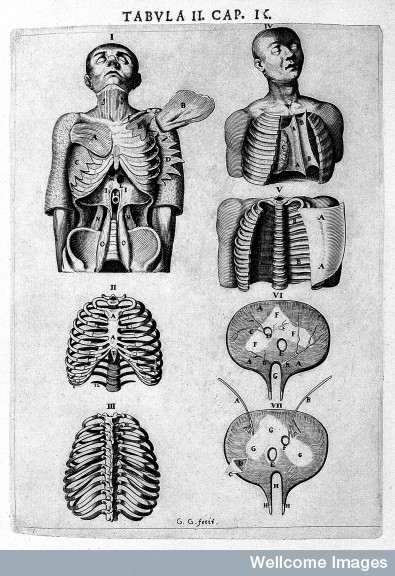
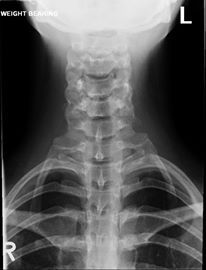 During my PhD I had trouble with my arms. After speaking to a fantastically enthusiastic surgeon it was revealed that I have cervical ribs. An extra set of ribs growing out of my cervical spine (you can see my x-ray here). These spare ribs complicate the placement of my blood vessels and nerves. I have been intrigued whether early modern anatomists and medical men ever came across someone with this condition and how they described it. Yesterday I was re-reading Michael Stolberg’s excellent article ‘A Woman Down to Her Bones’ and noted that one of the footnotes referred to medical texts that acknowledged that some people had extra ribs. I couldn’t resist looking up what they said.
During my PhD I had trouble with my arms. After speaking to a fantastically enthusiastic surgeon it was revealed that I have cervical ribs. An extra set of ribs growing out of my cervical spine (you can see my x-ray here). These spare ribs complicate the placement of my blood vessels and nerves. I have been intrigued whether early modern anatomists and medical men ever came across someone with this condition and how they described it. Yesterday I was re-reading Michael Stolberg’s excellent article ‘A Woman Down to Her Bones’ and noted that one of the footnotes referred to medical texts that acknowledged that some people had extra ribs. I couldn’t resist looking up what they said.
The English translation of Isbrand van Diemerbroeck’s Anatomy of Human Bodies emphasises how rarely they saw occurrences of extra ribs:
These are reckoned to be twelve on each side, seldom more or less. Galen writes, that a thirteenth is very rarely to be found, and more unusually eleven.
It is estimated that today cervical ribs can be found in about 0.5% of the population.1 He went on to note that a French soldier was found to only have
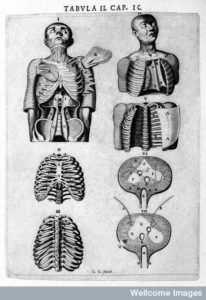
eleven in 1641 when he was killed with a sword. Italian anatomist and physician Gabriele Fallopius, he claimed, had seen a body with thirteen on one side. While he had a skeleton in his own possession that ‘almost’ wanted the twelfth rib on either side. He said almost because they were there but ‘so small, that it hardly exceeds a Thumb’s breadth’ – I image a little like my extra ones.2
This phrasing was used in many texts. Thomas Bartholin’s anatomical textbook likewise said that ‘they are on each side twelve, both in men and women. Seldome thirteen, more rarely eleven’.3 So no mention yet of 14 ribs. Some writers like Bartholin used the presence of this extra rib in some people to explain the biblical story of Adam and Eve. He argued that ‘Tis therefore likely that in one side of Adam there were thirteen ribs, one of which Jehovah took out with the musculous flesh growing thereto and turned into Eve‘.4 Medicine now suggests that the presence of cervical ribs is actually more common in women.5
The rarity of the condition meant that some anatomists never saw a body with this variation. Alexander Monro the Edinburgh anatomist wrote that Diemerbroeck had collected together relevant stories but that ‘None of the Bodies I have dissected were endued with any but the common Number.’6
It wasn’t until the 19th century when Charlotte D – a 26-year-old servant was admitted to St Bartholomew’s Hospital that cervical ribs and the associated ‘Thoracic outlet syndrome’ really became an object of study.7 And it was not until the 20th century that the use of x-rays facilitated diagnosis in patients. Yet early modern anatomists were willing to acknowledge and record the variations they witnessed in rib formation.
_______________
- http://pubs.rsna.org/doi/pdf/10.1148/radiographics.19.1.g99ja02105 p.111.
- Isbrand van Diemerbroeck, The anatomy of human bodies, comprehending the most modern discoveries and curiosities(London, 1694 edition) ,p. 593.
- Thomas Bartholin, Bartholinus Anatomy (London, 1668), p. 353.
- Ibid.
- http://pubs.rsna.org/doi/pdf/10.1148/radiographics.19.1.g99ja02105 p.111.
- Alexander Monro, The anatomy of the humane bones (Edinburgh, 1726), p. 240.
- Karl A. Illig, Robert W. Thompson, Julie Ann Freischlag, Dean M. Donahue, Sheldon E. Jordan, Peter I. Edgelow, Thoracic Outlet Syndrome (New York, 2013), p. 4.
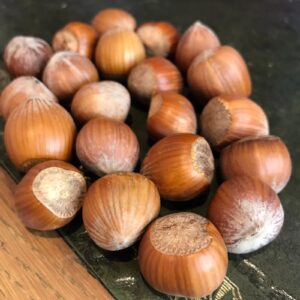
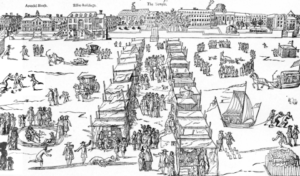


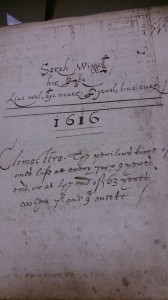
The Thoracic outlet syndrome can also be associated with fibrous bands in the position that a cervical rib would have had. They might be a ‘forme fruste’ of cervical ribs.
Absolutely, I thought that might be a bit too much for readers of the blog though.